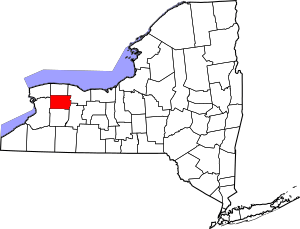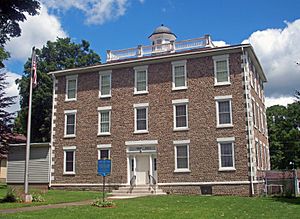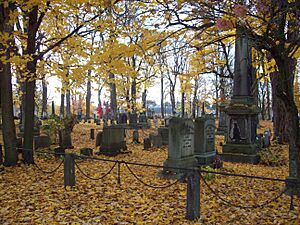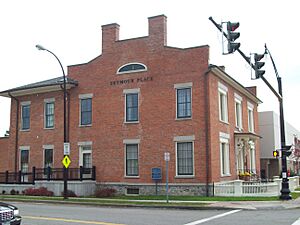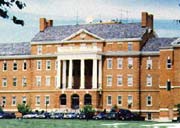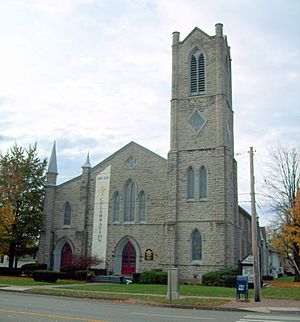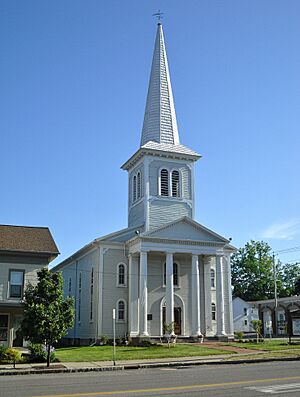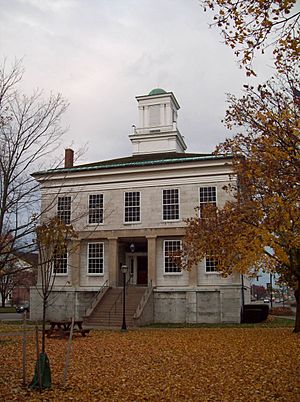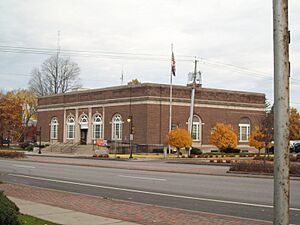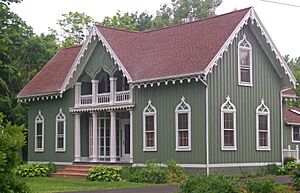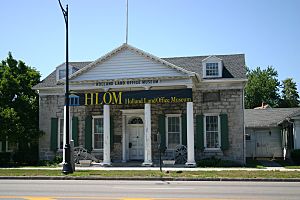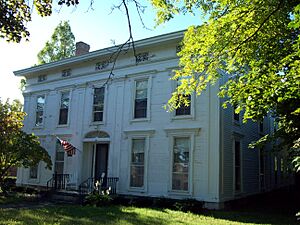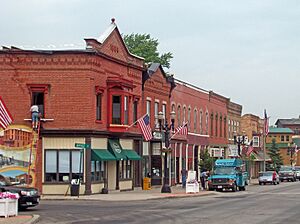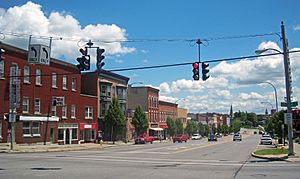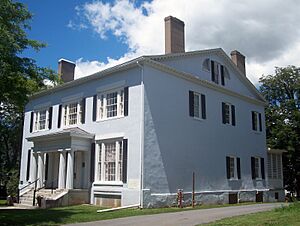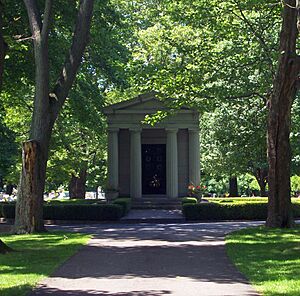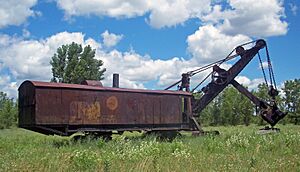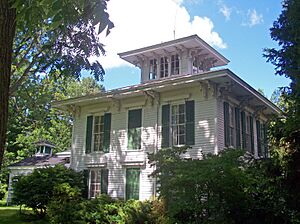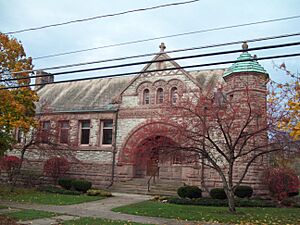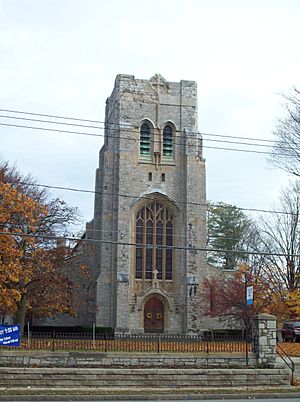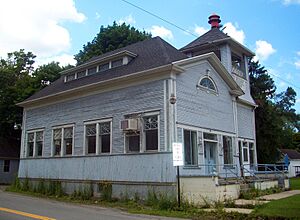National Register of Historic Places listings in Genesee County, New York facts for kids
Genesee County, located in the beautiful state of New York, is home to many special places. These places are listed on the National Register of Historic Places. This is an official list kept by the United States government. It includes buildings, sites, and districts that are important to American history, architecture, archaeology, engineering, or culture. When a place is on this list, it means it's recognized for its historical value and efforts are made to protect it.
This list helps us learn about the past of Genesee County. It shows us where important events happened, where famous people lived, or where unique buildings were constructed. One very important place, the Holland Land Office, is even more special. It is a National Historic Landmark, which is the highest honor a historic place can receive in the U.S.
Contents
- Historic Places in Genesee County
- Alexander Classical School
- Batavia Cemetery
- Batavia Club
- Batavia Veterans Administration Hospital
- First Presbyterian Church (Batavia)
- First Presbyterian Church of Le Roy
- Genesee County Courthouse
- Genesee County Courthouse Historic District
- Gifford-Walker Farm
- Holland Land Office
- Keeney House (Le Roy)
- Lake Street Historic District (Bergen)
- Le Roy Historic District
- Le Roy House and Union Free School
- Machpelah Cemetery (Le Roy)
- Marion Steam Shovel (Le Roy)
- Morganville Pottery Factory Site
- Mount Pleasant (Indian Falls)
- Richmond Memorial Library
- Saint James' Episcopal Church (Batavia)
- Stafford Village Four Corners Historic District
- Augustus S. Tyron House
- U.S. Post Office (Le Roy)
Historic Places in Genesee County
Alexander Classical School
The Alexander Classical School is a very rare building. It was built in 1837 using a special method called cobblestone architecture. This means its walls are made from rounded stones found in fields. It's the only cobblestone building on this list in Genesee County!
This three-story building first served as a boarding school. Later, it became a public school for local children. After that, it was used as the town hall. It has a long history of serving the community.
Batavia Cemetery
The Batavia Cemetery has been a burial ground since 1823. Many important people from Genesee County's past are buried here. These include Joseph Ellicott, who helped plan much of Western New York, and the famous newspaper editors Albert Brisbane and Arthur Brisbane.
You can also find a large mausoleum, which is like a small building for burials, belonging to Dean Richmond. A tall monument in the cemetery remembers William Morgan. He disappeared in 1824, which led to a big political movement called Anti-Masonry.
Batavia Club
The Batavia Club building was constructed in 1831. It is a brick building designed in the Federal style, which was popular in the early days of the United States. It was originally built as a bank.
Today, this historic building serves as an arts center. It is one of only two buildings still standing in New York that were designed by the architect Hezekiah Eldredge.
Batavia Veterans Administration Hospital
The Batavia Veterans Administration Hospital is a significant site. It is part of a larger group of hospitals built for veterans after World War I. These hospitals were designed to provide care for soldiers who returned from war.
This hospital is recognized for its role in the history of healthcare for veterans in the United States.
First Presbyterian Church (Batavia)
The First Presbyterian Church in Batavia is a complex of buildings. It was built over many years, from 1854 to 1919. The different parts of the church show how American Protestant worship styles changed over time.
This church has been an important spiritual center for the community for over a century.
First Presbyterian Church of Le Roy
The First Presbyterian Church of Le Roy was built in 1825. It is home to one of the oldest church groups in the area, which was started in 1812. This makes it a very early and important part of the community's history.
Genesee County Courthouse
The Genesee County Courthouse is a grand Greek Revival building made of limestone. It was built in 1843. This courthouse replaced an earlier one that once served a huge area known as the Holland Purchase.
Local materials were used to build this impressive structure. It stands as a central point in Batavia's civic area and marks the western entrance to downtown.
Genesee County Courthouse Historic District
The Genesee County Courthouse Historic District is the heart of Batavia's government area. It includes five government buildings located where old Iroquois trails once met. These buildings were constructed between the 1840s and the 1920s.
This district shows how Batavia grew as an important center for government and community life.
Gifford-Walker Farm
The Gifford-Walker Farm features an intact farmhouse built in 1870. It is designed in the Carpenter Gothic style. This style often includes decorative wooden trim that looks like it was carved by hand.
The farm gives us a good look at what rural life and architecture were like in the late 1800s.
Holland Land Office
The Holland Land Office is a very important building. Built in 1815, this Greek Revival style building was the main office for the original owners of all of Western New York. These owners were called the Holland Land Company.
This office was where land was sold and managed for a vast area. It played a key role in the early development of the region. It is also a National Historic Landmark, meaning it's one of the most historically significant places in the country.
Keeney House (Le Roy)
The Keeney House was built in the 1820s in the Federal style. It later became the home of the person who invented the "stringless bean." Over time, the house had some Greek Revival decorations added, but these were removed in the early 1900s to bring it back to its original look.
Lake Street Historic District (Bergen)
The Lake Street Historic District in Bergen is a small collection of buildings. These buildings were constructed in the late 1800s and early 1900s. Many of them have interesting cast iron storefronts, which were popular at the time.
This district shows the style of downtown buildings from that period.
Le Roy Historic District
The Le Roy Historic District forms the core of the historic village of Le Roy. This village grew up around the famous Jell-O plant and the Oatka Creek. The district includes many buildings that show the village's development over time.
It's a great place to see the history of a small American town that became famous for a sweet treat!
Le Roy House and Union Free School
The Le Roy House started as a land office in 1823. It was expanded in three stages by Jacob Le Roy into an ornate Greek Revival house. Today, it is a local historical museum.
Behind the house is an 1898 school building. This was the first building constructed by the current Le Roy school district. Now, it is used as the Jell-O museum, celebrating the dessert that was invented in Le Roy.
Machpelah Cemetery (Le Roy)
Machpelah Cemetery is a rural cemetery that opened in 1858. It has grown over the years. The grave markers here show many different styles of funerary art from the past to the present day.
The famous Jell-O tycoon, Orator Francis Woodward, is buried here in a large Classical Revival mausoleum.
Marion Steam Shovel (Le Roy)
The Marion Steam Shovel in Le Roy is a very unique piece of machinery. It is the only remaining Marion Model 91 steam shovel left in the world. It might even be the largest steam shovel still in existence!
This powerful machine may have been used to help dig the famous Panama Canal. It's a great example of early industrial engineering.
Morganville Pottery Factory Site
The Morganville Pottery Factory Site is where a factory operated for most of the 1800s. This factory made drain tiles and ceramic tiles. In 1973, archaeologists from the Rochester Museum and Science Center excavated the site.
There might still be more artifacts to discover here, telling us more about how things were made long ago.
Mount Pleasant (Indian Falls)
Mount Pleasant is a sophisticated farmhouse built in 1861. It is designed in the Italianate style, which was popular for its decorative features and tall, narrow windows.
This house is a beautiful example of mid-19th-century architecture in the area.
Richmond Memorial Library
The Richmond Memorial Library was built in 1887. It is designed in the Richardsonian Romanesque style. This style is known for its heavy stone construction, round arches, and detailed carvings.
The library was designed to look like several other libraries built by the famous architect Henry Hobson Richardson in the Boston area.
Saint James' Episcopal Church (Batavia)
Saint James' Episcopal Church was built in 1908. It is a beautiful example of Neo-Gothic style. This style brings back the look of medieval cathedrals with pointed arches and stained glass.
This church was the first of many in Western New York designed by the architect Robert North.
Stafford Village Four Corners Historic District
The Stafford Village Four Corners Historic District includes buildings from the 19th century. This area was one of the first permanent settlements in the Holland Purchase, continuously existing since 1798.
The district includes one of the oldest houses in Genesee County and a former town hall with a unique design. It shows the early history and growth of the region.
Augustus S. Tyron House
The Augustus S. Tyron House is located in Le Roy. It was added to the National Register of Historic Places in 2013. More details about its history and architecture make it a notable part of the area's heritage.
U.S. Post Office (Le Roy)
The U.S. Post Office in Le Roy was built in the late 1930s. A local person paid for the stone used to cover the building. This gives it a unique design compared to other post offices in New York State.
It's an interesting example of how local support can influence public buildings.


